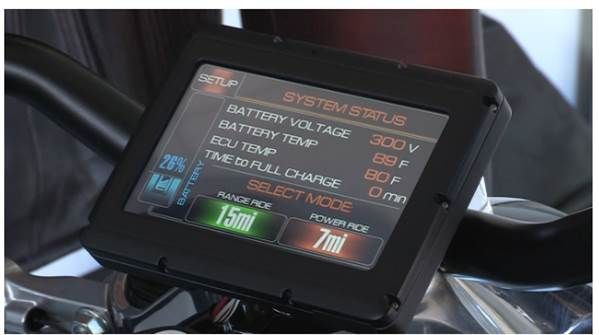I'm curious where BrammoBrian got his 7.8 kWh pack size specification from, but I assume he has his sources : ) (perhaps 311V 25Ah .. maybe they're using the same farasis cells as Brammo / Zero)
*Brian's personal speculation*
In one of the videos, you can see the display showing battery voltage, SOC, and range estimate.

It's also been made clear that Harley have worked with Mission on the bike, and most likely will have sourced the battery from them as well. Mission lists their module specification on their website. What seems to make sense knowing what I do about the Mission R is that they constructed a pack from 4 of their EV modules in series = 96S 1P = 350Vdc (nominal) / 20Ah = 7.0kWh. The 350Vdc nominal pack would be at about 25% SOC at 300V and 0% at 288Vdc, so that seems to work. That would yield a pack weight of about 130lbs given the specific energy of the Mission battery at 123Wh/kg. Peak power would be scaled from the Mission datasheet to be about 8.5C, or 60kW, which corresponds nicely to the 55-57kW peak power claim by Harley.
Using general driving efficiency numbers of the Empulse, that yields an average driving range of about 45 miles and a maximum (city drive profile) range of 98 miles, which is also pretty darn close to the 53/100 claim.
The pack size is probably small for a number of reasons:
1. They followed a traditional approach on designing the bike where they gave the stylists first crack and then left it to the engineers to fit the "package".
2. A small battery means less cost on the most expensive component, thus it made their internal business case look reasonable.
3. As others have suggested, a small battery would benefit handling and acceleration, which will be rated on the tour more over range.
Another possibility is that it's a 2P battery pack and they've got 14.0 kWh on-board, but I doubt they would claim such low range with such high capacity. Or... they could've sourced the battery somewhere else and I'm way off base...
